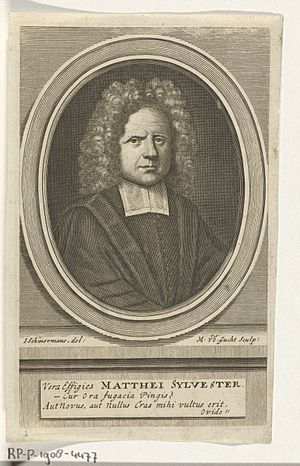Matthew Sylvester facts for kids
Matthew Sylvester (born around 1636 in Southwell, Nottinghamshire, died 1708 in London) was an English Nonconformist minister. Nonconformists were Protestants who did not follow the rules of the official Church of England.
Early Life and Education
Matthew Sylvester was born in Southwell, Nottinghamshire, around 1636. His father, Robert Sylvester, was a merchant who sold fabrics. Matthew went to the grammar school in Southwell.
When he was seventeen, in 1654, he started studying at St. John's College, Cambridge. However, he did not have much money. This meant he could not stay at college for very long. Even so, he continued to study on his own. He supported himself, probably by teaching. Through his hard work, he became very good at languages. He also learned a lot about philosophy, which is the study of knowledge and existence.
Becoming a Minister
Around 1659, Matthew Sylvester became the vicar of Great Gonerby in Lincolnshire. A vicar is a type of Christian minister. He was related to Robert Sanderson, who became a bishop in 1660.
In 1662, a new law called the Act of Uniformity was passed. This law required all ministers to follow strict rules of the Church of England. Because Matthew Sylvester was a Nonconformist, he chose to leave his position. He even turned down an offer from his relative, Bishop Sanderson, to stay.
After leaving his church role, he worked as a private chaplain. First, he worked for Sir John Bright, 1st Baronet. Later, he worked for John White, another Nonconformist.
Life in London
In 1667, Matthew Sylvester moved to London. There, he became the leader of a church group at Rutland House. He was friends with many important London church leaders. These included Benjamin Whichcote and John Tillotson.
A famous minister named Richard Baxter became Sylvester's assistant in 1687. Baxter did not take any pay for this. He admired Sylvester for being kind and having good ideas. Baxter was a great speaker, which helped Sylvester, who was not as good at giving sermons. However, Sylvester was known for his amazing prayers.
After Richard Baxter died in 1691, the church group became smaller. In 1692, they moved to a new building. Edmund Calamy worked as Sylvester's assistant from 1692 to 1695. Calamy described Sylvester as a very quiet and calm person. He also mentioned that Sylvester did not have much money. Matthew Sylvester continued to lead the church by himself until he died. He passed away suddenly on January 25, 1708.
Important Writings
Matthew Sylvester published several sermons. He also wrote introductions for books by other famous ministers.
His most important work was helping to publish the writings of Richard Baxter. In 1696, he released a large book called Reliquiæ Baxterianæ. This book contained Baxter's life story and important events from his time. Sylvester also included the sermon he gave at Baxter's funeral.
Editing this book was a big challenge for Sylvester. Baxter had left many unorganized papers. Sylvester decided to copy everything himself, even though his hand was weak. The book ended up having many mistakes because Sylvester could not check the printing process closely. Despite these issues, the Reliquiæ Baxterianæ is still a very important historical book.


